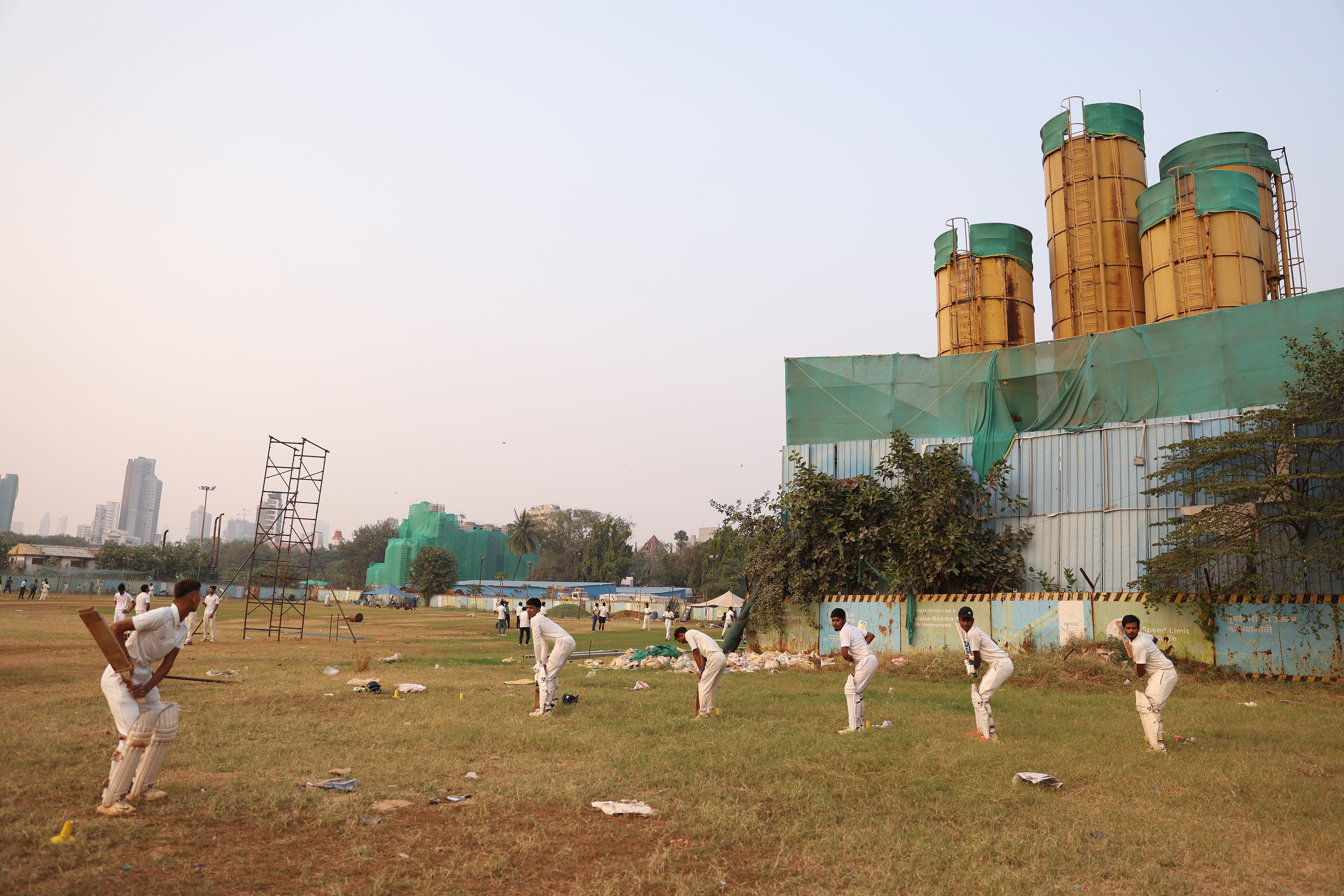Inside the magical Mumbai park where cricketing heroes and dreams are made
Cricket as a religion may be a tired trope, but it’s a way of life in Mumbai, says Cameron Ponsonby. Here, he tells the fascinating story of the place where rich meets poor and current superstar cricketer Yashasvi Jaiswal lived in a tent as a child before he was discovered...

Rishabh, a lad in his early twenties, has his pads on and is next up to bat. We’re in the heart of Mumbai at Cross Maidan, one of the few public cricket grounds – and green spaces too – that exist in this intensely busy city.
Today, a pretty average work match is taking place at one end, while in the middle of the ground, a glut of four matches on top of each other are underway, all of which are “open age-group” matches and being played at a high standard.
A young lad with a perfect action draws a false shot from the high-elbowed batter, who takes a diving catch as he flings himself forward, shredding his elbows in the process.
Later on, a young batter picks up consecutive short balls and nails them for six, only just keeping the ball in the ground on each occasion, but both times clearing the fielders of the match that was taking place just yards to his right.
“How often do people get hit?” I ask Rishabh, noting while doing so that the short cover on the match I was paying closest attention to was actually third man for another match I hadn’t noticed was happening diagonally from us.
“Not very often,” Rishabh replies. “Maybe… twice a day?”
The maidans in Mumbai represent both love and necessity. Love, because everyone plays here because they want to. And necessity, because everyone plays here because they have to. It would be easy to look at the acres of public parks, full to the brim with cricketers playing matches from noon till night and conclude that this is India. The romantic vision of a nation where “cricket is like a religion”.
But the truth is that the maidans aren’t a representation of cricket in India, but cricket in Mumbai. A sprawling metropolis of 23 million people all on the move, all at the same time. There is next to no green space available because everything has been built on. As such, the public parks, or Maidans, are nigh on the only places in the city where you can play.
The three most famous maidans are situated in Colaba in the south of the city. The most well-known – and largest – is Oval Maidan, the next biggest is Cross Maidan, which while smaller, sees more matches taking place at once, and then Azad Maidan.

While no one maidan is considered more prestigious than another, each has its own quirks and reputations. For instance, Cross Maidan is known to have the trickiest batting conditions. And it is for this reason that, for any team or youngster that is craving to be spotted, a mammoth innings here is required.
Everyone plays across these three grounds, all of which are within walking distance of one another. It is one of the great cultural levellers of Mumbai society. The richest and poorest kids are all in the same place and going toe-to-toe.
For the majority, the chance to play against the most elite schools brings added opportunity, and a chance to practise your swear words and short-pitched bowling. As Bharat Sundaresan, a leading cricket journalist who grew up in Mumbai, tells me: “The shinier the helmet, the faster the bouncer.”
This coming together of cultures is best seen at Azad Maidan. The smallest of the three, Azad Maidan is home to the origin story of current Indian superstar Yashasvi Jaiswal, who moved to Mumbai as a child and lived in a tent on the grounds for three years while selling the roadside snack pani puri to make ends meet. His rise to the Indian team to become a modern great from abject poverty is one of the most inspiring sporting tales in the world.
Maidans should be celebrated in the context that they exist, as a symbol of cricket’s popularity in India, but also its reality in Mumbai
I knew this story before arriving at the ground. What I didn’t know was that sharing the space with Azad Maidan is Bombay Gymkhana, one of Mumbai’s most prestigious private clubs. The neatly kept lawns of one side are separated from the dusty outfields of the other only by a public path and a low net.
Bombay Gymkhana is a historic sport and private members’ club. It is the location of India’s first home test, of Sachin Tendulkar’s first professional match and one of India’s few rugby clubs. The reason that such wealth shares a space with the rest of society can be found in the name of the ground they share, “Azadi”, which means liberty or freedom in Persian.
In short, Bombay Gymkhana was previously a British-only establishment with no Indians allowed on any of its grounds. But now, the maidan is free to use for everyone, Bombay’s own pitch being the only private property here.
The maidan also holds enormous political significance. In 1931, after his release from prison, Mahatma Gandhi gave a speech from here and to this day political rallies are held here on a daily basis.
In short, from one public path, you can turn to your left and imagine the tent that Jaiswal had to live in for three years from age 12 to 15, turn to your right and see the wealthiest members’ club in the city, and then look straight ahead for the protest you want to go to once you’ve become angry about it all.
The “cricket is a religion” trope in India is a tired one. A better analogy from an English point of view would be to describe it as being like football.

Incredibly popular, with some people giving it a miss, but it is ultimately a sport that everyone’s going to have a go at. The result is that watching the dozens of matches playing out in front of you is much like going down to your local five-a-side power league in London. Some people are good, some people are very good and some people are really bad. Exactly the way it should be.
These grounds are home to where Indian greats such as Tendulkar and Vinod Kambli shared a 664-run partnership when at school, or where current India Test players Sarfaraz Khan and Prithvi Shaw registered scores of 439 and 546 as teenagers, but the real joy as an outsider lies in witnessing the sheer mass of competency playing out in front of you.
Capable cricketers, with the odd exception, as far as the eye can see, is as alien a concept as it is a joyful one when you’re from a nation that prides itself on bad-quality cricket being played on the village green.
Girls are increasingly playing at the maidans, but the picture today is of a sea of boys. The collective dream is to play at the Wankhede Stadium, the host of the 2011 World Cup Final and the home of the IPL team Mumbai Indians.
And in almost cringeworthy fashion, the reminder of that dream is ever present with the floodlights of the ground visible from Cross Maidan – in sight, but in reality, also out of reach.
If you want to get noticed by the MCA (Mumbai Cricket Association) and get on the pathway, the place to do so is in the two main school competitions that take place, one of which is The Harris Shield. Scores of 300-plus are required to gain attention and as a result, the sporting prodigies will hardly ever be seen in the classroom.

They’ll be on the books of the school, but not reading them, with everyone’s priority that they spend time in the nets rather than chemistry. The best of the best are seldom required to field so they don’t risk injury from a dodgy bounce. In short, you bat all day, don’t go to school and don’t have to field. Sounds amazing.
Home and away matches don’t exist in the way someone from the UK would consider them. Instead, matches are arranged in the proximity of the two clubs and it goes from there.
There are private grounds that can be rented for special, often corporate occasions, and the very top level of amateur cricket is sometimes played on standalone pitches elsewhere in the city, but equally, they will often be played mixed in with the rest as well.
The maidans should be celebrated in the context that they exist, as a symbol of cricket’s popularity in India, but also its reality in Mumbai. Rather than a drink after play, it’s a quick pani puri and a chai with your mates on the corner from the same vendor you’ve known forever before catching the train home.
It isn’t the same playing and post-match experience as the UK, another crucial difference being that you don’t have to wait all week before getting to see your mates again and having a hit. The action all starts again the very next day.
Join our commenting forum
Join thought-provoking conversations, follow other Independent readers and see their replies
Comments


Bookmark popover
Removed from bookmarks